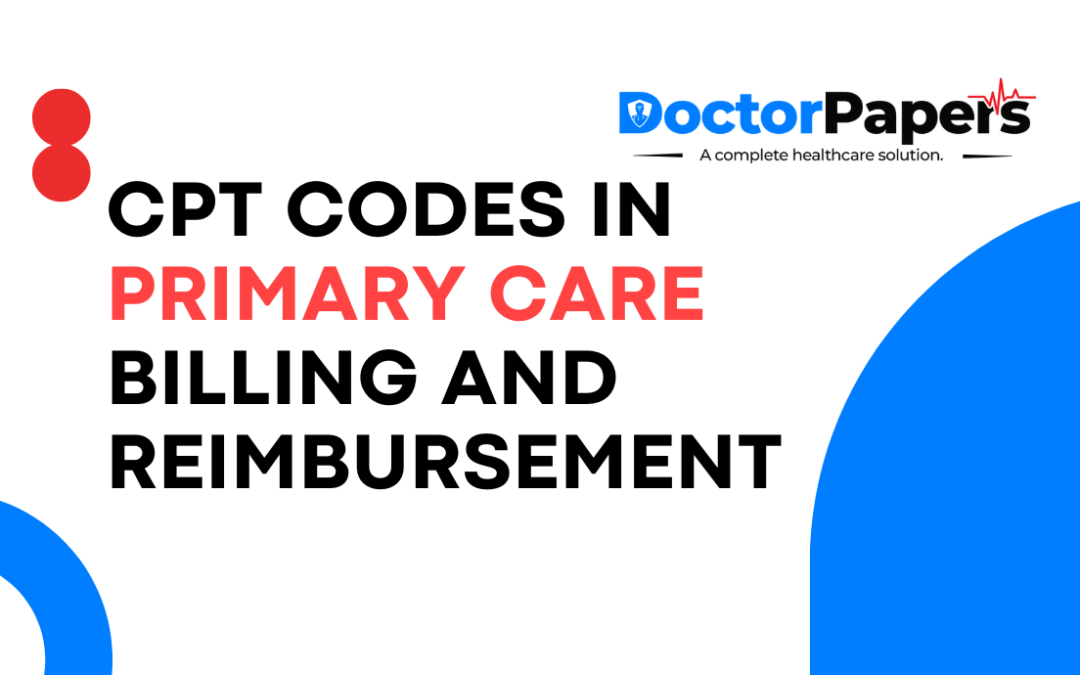Accurate coding is crucial for effective revenue management in healthcare. We will cover the fundamental codes for typical procedures, exams, and treatments. Whether you’re an experienced practitioner or new to primary care, this guide will help you navigate the complexities of primary care billing and reimbursement. Get ready to master effective coding and maximize reimbursement.
Office visit – Procedure CPT codes for primary care billing
Here’s an explanation of each code and its significance
99202: A level 2 new patient office visit is represented by this code. This code is used when a physician examines a new patient with a simple medical complaint or condition that only necessitates minimal medical decision-making.
99203: A level 3 new patient office visit is represented by this code. It is applied when a doctor examines a new patient who has a medical condition or complaint of moderate complexity and calls for some degree of medical decision-making.
99204: A level 4 new patient office visit is represented by this code. This code is employed when a doctor examines a new patient with a more severe illness or complaint that calls for a high level of medical decision-making.
99211: This code indicates a level 1 established patient office visit. It is used when a doctor visits an existing patient for a quick, uncomplicated examination or minimum treatment.
99212: This code represents a level 2 established patient office visit. The code is utilized when a physician checks a verified patient with a simple medical problem or complaint that calls for just a little degree of medical decision-making.
99213: This code designates a level 3 established patient office visit. It is used when a doctor examines a patient who has been treated before with a medical condition or complaint of moderate complexity that calls for certain medical decision-making.
99214: This code designates a level 4 established patient office visit. It is applied when a doctor examines a patient who has been treated before but has a more complicated illness or complaint that calls for a high level of medical judgment.
99215: A level 5 established patient office visit is represented by this code. It is applied when a doctor examines a patient with a history of a severe medical condition or complaint that necessitates making many sophisticated medical decisions.
These CPT codes are essential in preventive medicines practices for several reasons:
Paperwork and Billing: Healthcare professionals may effectively charge and document their services with the use of CPT codes. Providers can guarantee sufficient reimbursement for their treatment by utilizing principles that correlate to the degree of complexity and medical decision-making involved in each office visit.
Stability and Standardization: CPT codes assist in creating a stable and standard coding and billing system for office visits. This makes it easier to compare the services offered by various healthcare providers and makes data analysis for research, quality improvement, and the creation of healthcare policy easier.
Reimbursement Verification: CPT codes are used by payers and insurance companies to verify that office visits are properly reimbursed. The resources needed to provide care for patients with various medical requirements are apparent in the different reimbursement rates corresponding to the complexity and level of medical decision-making connected with each code.
Communication and Care Consistency: Healthcare practitioners can efficiently communicate with other medical professionals, such as specialists or consultants, about the type of care given to a patient by using standardized CPT codes. It promotes appropriate referrals or further action and ensures continuity of treatment.
Preventative visit – Primary care billing codes
These codes categorize and charge for various patient age groups receiving preventative care treatments.
Preventive examinations are a critical part of preventive medicines to encourage well-being, prevent disease, and identify possible health concerns early on. These appointments frequently include thorough examinations, tests, vaccines, counseling, and education catered to the patient’s particular age group.
Let’s categorize the CPT codes by a range of ages:
99381: Preventive visits for new patients under the age of 1 year.
99382: Preventive visits for new patients aged 1-4.
99383: Preventive visits for new patients aged 5-11.
99384: Preventive visits for new patients aged 12-17.
99385: Preventive visits for new patients aged 18-39.
99386: Preventive visits for new patients aged 40-64.
99387: Preventive visits for new patients aged 65 and over.
The above codes are for new patients visiting a provider for the first time and seeking preventive care services.
99391: Preventive visits for established patients who are younger than a year.
99392: Preventive visits for established patients between the ages of 1-4.
99393: Preventive visits for established patients aged 5-11.
99394: Preventive visits for established patients aged 12-17.
99395: Preventive visits for established patients between 18-39.
99396: Preventive visits for established patients aged 40-64.
99397: Preventive visits for established patients aged 65 and over.
These codes apply to patients who have an established relationship with their physician and are returning for routine preventative treatment.
Primary care preventive visits detect and address health issues before they become problematic. Medical professionals may diagnose cancer, diabetes, and hypertension, give vaccinations, advise on lifestyle, and recommend preventative measures depending on age and risk factors.
Conclusion
These codes act as a standard language that enables precise documentation, correct invoicing, and fair reimbursement for services provided. Primary care professionals may expedite their billing procedures, minimize mistakes, and guarantee the highest possible reimbursement by being familiar with the relevant CPT codes.










